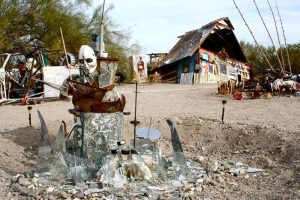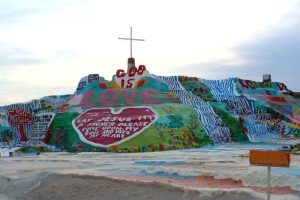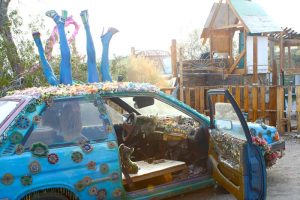It is interesting that when one begins to type “Niland” into the search bar, the first suggestion that Google offers is “nihilism”; defined as “the rejection of all religious and moral principles, often in the belief that life is meaningless” and as “extreme scepticism maintaining that nothing in the world has a real existence”.
Slab City is almost the stuff of legends, but it is a real place where people live. What is it like to visit Slab City and should you though?
Background to Slab City
Niland, a small, isolated township with just over 1,000 residents, lies in the bowels of California’s arid the Sonoran Desert, just 50 miles short of the Mexican border. This sleepy town, scarred by decades of decay, may never have shown up on the global radar had it not been positioned four miles north of a rather extraordinary place; a place where cowboys exist, where homemade pirate ships are a viable transit option, where ancient men with rainbow beards exact wisdom, and where dolls heads and toilet seats ceremoniously garnish every second surface.
The short drive from Niland to Slab City is littered with dormant World War 2 viewing platforms and decaying vestiges of the sites’ military past. Once a Marine training base called Camp Dunlap, the base was once expected to prepare the United States Marine Corps for combat but was abandoned in 1956. Since then the site—soon baptized Slab City (after the concrete slabs which remained from the barracks)—cultivated a community of visitors, travellers, and long-term residents attracted by the remoteness and lawlessness of life deep in the desert. This patch of land is totally decommissioned and uncontrolled. There is no rent, no charge for parking, and no tax. The site has no official electricity, running water, sewers, toilets, or trash pickup service. This necessitates that the residents have Womble-like resourcefulness; makeshift homes being occasionally made out of old school buses, broken down trailers, or tents with added pallets and blankets for sturdiness, as well as fancy trailers with solar panels and extendable rooms. There’s even a church and a new library. People have survived the incredible heat and lack of state resources on Slab City’s 640 acres for decades. As “squatters” on state-owned land, it’s often referred to as “the last free place in America.” Indeed, many of us may have never even heard of the Slabs had it not been one of the settings featured in the Sean Penn film Into The Wild (2007) (the part where a “16-year-old” Kristin Stewart attempts to seduce the movie’s main character, Christopher McCandless).
Weather in Slab City

Temperatures during the summer can be incredible (as high as 48 °C); nonetheless, there is a group of around 150 permanent residents who live in the Slabs all year round. Some of these “Slabbers” derive their living from government programs and have been driven to the Slabs by poverty. Others have moved to the Slabs to live off the grid and to be left alone or even to stretch their retirement income. Some come just to have fun. For some, a mixture of all of the above applies. In Imperial County, where drug and alcohol admission rates are already over double the Californian average (Niland itself has one of the highest proportions of heroin and methamphetamine-related hospital admissions in the entire state) drug use is not uncommon, and common conservative rhetoric goes that Slab City is just a Mecca for people with drug problems to come and take advantage of the difficulty (and rarity) of emergency services going out there. Whatever the reason, Slab City is an unconventional but oddly cohesive community that places precedent on innovation, beauty, and rebellion.
Visiting Slab City
It sounded like a whole lot of crazy.
So in 2014, I decided to head off the beaten path and check it out for myself.
After not seeing another human for miles, through endless highways perforating the horizon and Indian reservations, we crawl into Niland and immediately notice a cowboy (complete with donkey) parked totally without irony next to a gas station. We get talking to this strange meme-worthy gentleman and his steed, affectionately named José Cuervo. The cowboy began, in hushed tones, to monologue about the “dark side” (read: fun side) of Niland and, in a way befitting of a cheesy plot device, segued into a short but thrilling description of the Slabs. The word “gnarly” was used. We quickly left the cowboy and José and followed the desert track towards perhaps the strangest place on Earth.

We passed the aforementioned church and library—both perched on wooden beams and looking like somewhere in between a fancy festival toilet and a beach hut—and of course Salvation Mountain, possibly the most easily recognized landmark of the Slabs. We drove, looking for a place to park up until we stumbled by chance upon a small yard signed ‘East Jesus’. Stepping out of the bus in stunned muted silence, we found ourselves looking upon a plethora of fantastical technicolour, perpetual motion, and confusingly abstract creations. It was like arriving on a Dr. Seuss-themed planet only with less Lorax and more bejewelled sex dolls. We slowly walked up a path lined with ornamental rubber ducks and walked towards a half-submerged bus from which the sound of laughter was coming, when we were greeted by a friendly, wild man who charismatically described what life was like in East Jesus, giving brief descriptions of the many installations dotted around. On reflection, odd men appearing from surprising locations to tell us about Slab City happened quite often. Residents of East Jesus, meaning “middle of nowhere beyond the edge of services” frequently mentioned a God-like character called Charlie who founded the camp in 2007. Unfortunately, he died suddenly in 2011. They were quick to point out that while the site was made of garbage, Charlie had set a high precedent of cleanliness and respect for the installations.
The “labyrinthian central complex” he created is home to administrative and hospitality facilities such as a fully equipped kitchen, showers, and toilets (all eco-friendly of course), as well as a musical performance space with a studio grand piano, PA, and full stage lighting system. It has all the necessary amenities of a western residence, whilst being “a living, growing, and ever-changing artwork”. East Jesus is not only a space for artists—it also aims to create an environment where all creativity is cherished, by “[taking] away any stigma attached to failure, as failing is how we learn.” This is something I learned first-hand when trying to glue a doll’s head onto a broken mannequin for my (resoundingly unsuccessful) piece in the annual art slam. Instead of judging me for my excessive and redundant use of hot glue, one EJ resident politely advised me to “use the nail gun, sweetie, the nail gun is perfect for doll heads.” The people of Slab City create a microcosm where those who fall through the cracks of the modern world may thrive, while promoting a “reuse before recycle” mentality, in order to create something from the detritus they scavenge, find, or are given.
In the following days we would live, talk, and party with the locals, who invited us into their ragtag homes. We were even lucky enough to be invited to their prom, held on the last weekend of spring (as many Slabbers leave the desert during the excruciating summer). This—like my own prom—was a slow decline into intoxication involving cheap nasty wine (and “chocolate martinis” – Charlie’s favourite), a chaffing and ridiculous dress, and intense conversations that I forgot immediately on waking up the next morning (afternoon)… only with slightly more cowboys and Alsatians. An old, wise bearded man sprung up at one point to give me a small pipe made from one of his rifle bullets as well as—you guessed it—to talk about the Slabs. The experience was unimaginable.

The following day, we boarded a large wooden pirate ship fitted with a car engine in search of a manmade canal in the middle of the desert (used to pump water from distant Colorado to southern California). The bright blue of the water cast against the parched beige of the desert was quickly punctuated by about thirty naked humans, jumping in and floating gently downstream. It was such a serene and beautiful afternoon, and will forever change the way I look at canals.
Could you live here?
What started as a visit we expected to last for a few hours, ended up lasting three days, and left us smiling for the entire long drive home. Our RV seemed like a crap consolation prize after tearing it up in a pirate ship. In the short time I was there we saw no one who seemed like they were forced to live there due to the ‘evil forces of capitalism’. Everyone we met seemed at peace, fulfilled, fiercely proud, and ostensibly smug about the life they had created for themselves.
For a while after my visit to Slab City, I questioned why I had to go to work and battle with estate agents when I could be living in a glittery treehouse shooting cans butt-naked in the desert.
In fact, some days I still wonder.






